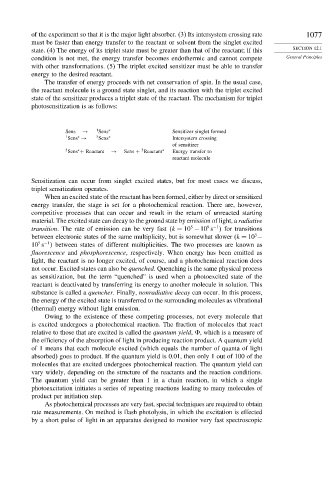Page 1092 - Advanced Organic Chemistry Part A - Structure and Mechanisms, 5th ed (2007) - Carey _ Sundberg
P. 1092
of the experiment so that it is the major light absorber. (3) Its intersystem crossing rate 1077
must be faster than energy transfer to the reactant or solvent from the singlet excited
state. (4) The energy of its triplet state must be greater than that of the reactant; if this SECTION 12.1
condition is not met, the energy transfer becomes endothermic and cannot compete General Principles
with other transformations. (5) The triplet excited sensitizer must be able to transfer
energy to the desired reactant.
The transfer of energy proceeds with net conservation of spin. In the usual case,
the reactant molecule is a ground state singlet, and its reaction with the triplet excited
state of the sensitizer produces a triplet state of the reactant. The mechanism for triplet
photosensitization is as follows:
Sens → 1 Sens ∗ Sensitizer singlet formed
1 ∗ 3 ∗
Sens → Sens Intersystem crossing
of sensitizer
3
3 Sens + Reactant → Sens + Reactant ∗ Energy transfer to
∗
reactant molecule
Sensitization can occur from singlet excited states, but for most cases we discuss,
triplet sensitization operates.
When an excited state of the reactant has been formed, either by direct or sensitized
energy transfer, the stage is set for a photochemical reaction. There are, however,
competitive processes that can occur and result in the return of unreacted starting
material. The excited state can decay to the ground state by emission of light, a radiative
9 −1
5
transition. The rate of emission can be very fast k = 10 − 10 s for transitions
3
between electronic states of the same multiplicity, but is somewhat slower (k = 10 −
5 −1
10 s between states of different multiplicities. The two processes are known as
fluorescence and phosphorescence, respectively. When energy has been emitted as
light, the reactant is no longer excited, of course, and a photochemical reaction does
not occur. Excited states can also be quenched. Quenching is the same physical process
as sensitization, but the term “quenched” is used when a photoexcited state of the
reactant is deactivated by transferring its energy to another molecule in solution. This
substance is called a quencher. Finally, nonradiative decay can occur. In this process,
the energy of the excited state is transferred to the surrounding molecules as vibrational
(thermal) energy without light emission.
Owing to the existence of these competing processes, not every molecule that
is excited undergoes a photochemical reaction. The fraction of molecules that react
relative to those that are excited is called the quantum yield, , which is a measure of
the efficiency of the absorption of light in producing reaction product. A quantum yield
of 1 means that each molecule excited (which equals the number of quanta of light
absorbed) goes to product. If the quantum yield is 0.01, then only 1 out of 100 of the
molecules that are excited undergoes photochemical reaction. The quantum yield can
vary widely, depending on the structure of the reactants and the reaction conditions.
The quantum yield can be greater than 1 in a chain reaction, in which a single
photoexcitation initiates a series of repeating reactions leading to many molecules of
product per initiation step.
As photochemical processes are very fast, special techniques are required to obtain
rate measurements. On method is flash photolysis, in which the excitation is effected
by a short pulse of light in an apparatus designed to monitor very fast spectroscopic

